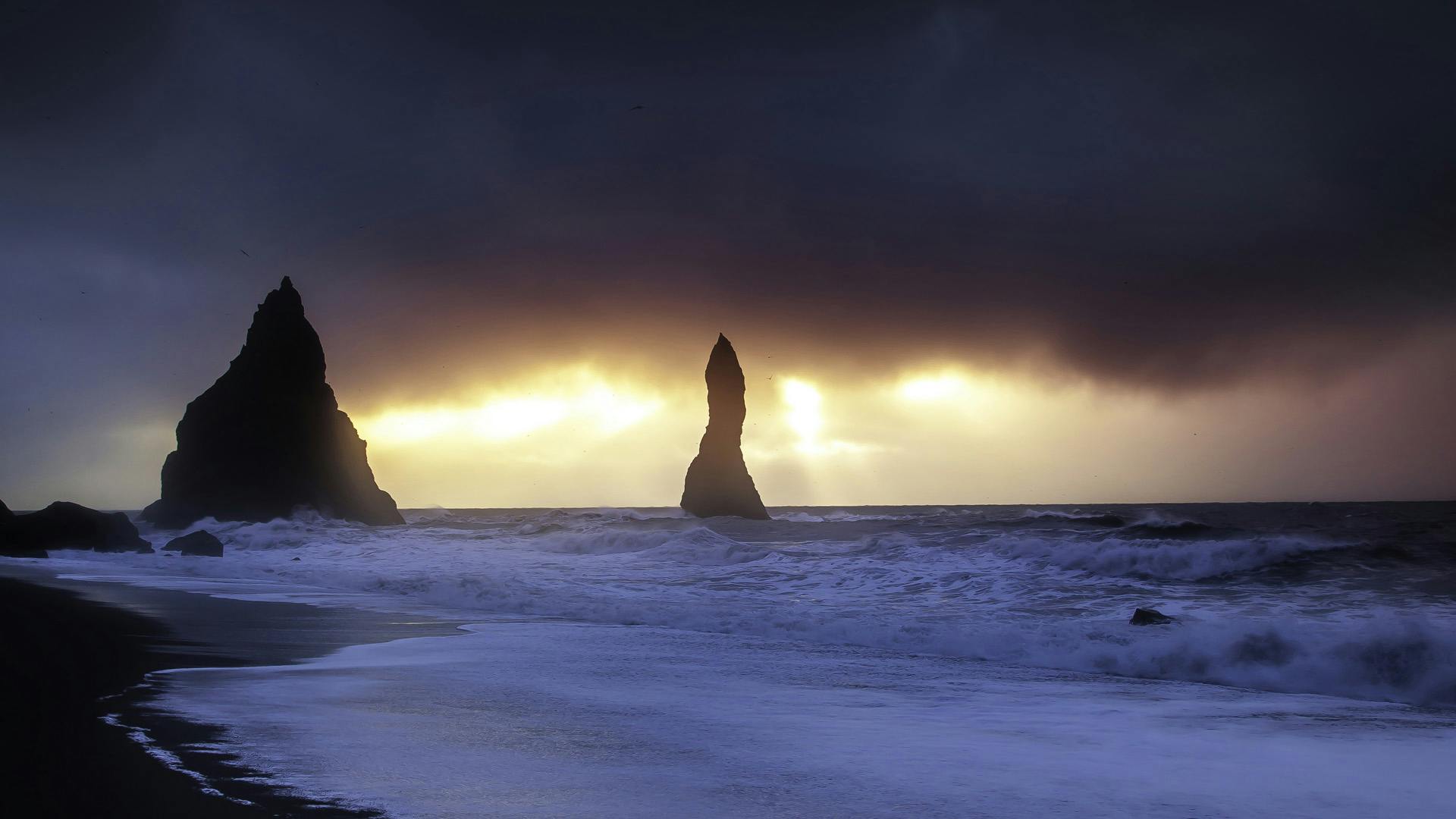
Reynisfjara – Black Sand Beach in Iceland
Welcome to Reynisfjara – a beach that has been ranked as one of the most beautiful beaches in the world.
What is Reynisfjara
Reynisfjara is a black sand beach that was naturally created due to volcanic activity in the area (read more in ‘’How was Reynisfjara formed’’). In fact the majority of beaches in Iceland are made of black sand, so this one doesn’t stand out in that regard. It is special because of some other magnificent features that cannot be found anywhere else.
The Reynisfjara beach includes massive stacks of basalt, basalt grottoes, hexagonal basalt columns, high cliffs, lava formations, black coastline, and magnificent stone arches.
How was Reynisfjara formed
Reynisfjara was formed due to the volcanic activity in the area during the last few centuries. Each time the dangerous Katla volcano erupted, the lava reached the North Atlantic Ocean. Once lava and sea get in contact with each other, lava instantly cools down, hardens and becomes black. And this is the reason why the black sand beaches are black. Eventually the volcanic lava heavily erodes by time, making the lava rocks as small as sand.
Where is The Black Sand Beach (Reynisfjara)
The Black Sand Beach (also known as Reynisfjrara or Reynisdrangar) is located at the southernmost tip of Iceland – around 180km (112 miles) from Reykjavik. The drive to the beach is easy (if the weather conditions are good) – which takes around 2.5 hours along the Ring Road. You got to take a right turn before the town of Vik, down a winding, pot-holed road towards the shoreline.
In case you do not have a car in Iceland, a popular way of getting there is by hitchhiking or taking a popular South Coast & Glacier Hike Day Tour from Reykjavik.
History of Reynisfjara
Reynisfjara translates to “Reynir’s beach” in Icelandic. Reynir is the name of the area that was colonized by Björn from Valdresi in Norway. In the late 9th century, when Iceland was just an empty land with almost no inhabitants, Norwegians found Iceland in the middle of the North Atlantic Ocean, and took over the land (due to a large number of fish).
The rules at the times were: first comes, first takes – and so was the case with Norwegian settlers. Take a multi day tour and our experienced guides will share all the details of the exciting history of medieval Iceland.
Pink sand at the Black Sand Beach
As the name suggests, Black Sand Beach is famous for its black sand. Although the majority of beaches in Iceland consist of black basaltic sand from ground basaltic lava, this one is usually an introduction to the coastline for most visitors. Our roads tend to avoid the strict vicinity of the coastline, since in stormy weather waves could interfere with traffic. Pink sand beach DOES exist in Iceland but it’s very far up North-West in a remote area and takes its colour from pulverized scallop shells.
Black Sand Beach is a Dangerous Place
Although beautiful, the Black Sand Beach is very dangerous. Almost every year for last couple of years it has claimed lives. If you’re looking into visiting the beach, beware for its strong and powerful sneaker waves. Once the sneaker wave takes you into the sea, there is no guarantee of getting out of it. There are many warning signs by the parking, lot so be sure to respect them. Getting even slightly too close to the ocean will put you at risk of being taken in. Don´t assume anything based on your previous experience with the sea. Ignore people getting close to the water, don’t follow them – they might be next ones to be dragged in. We always assume that the bad thing won’t happen to us specifically, but the signs are there for a reason.
Can I see puffins on the Black Sand Beach
The puffins often nest on the cliffs overlooking the beach. The chance of them coming to this location is around fifty percent.
How to tell them apart from other birds nesting on the cliffs? Tiny, black birds with colourful beaks flapping their wings like crazy – you see puffins aren’t great flyers and most of the year they spend on the sea in the middle of the ocean. They only come to dry land for breeding between March and August. They’re great divers though and that’s how they survive high surf. They can dive down to 65 meters (200 feet) and hold their breaths for a couple of minutes.
Their bones aren’t hollow like most other seabirds, their feathers are oily – that helps them dive faster and deeper. Vibrant beak colours come from beta-carotene found in shrimps, that their diet consists of.
Game of Thrones on Black Sand Beach
Multiple Game of Thrones episodes were shot on the Black Sand Beach. Google the images, so you can take the same shots (this time with you in the photo). Most notably a cavern found inside the cliff was used as Dragon Glass cave.
Northern lights on Black Sand Beach
Aurora can be seen just about anywhere in Iceland as long as the sky is clear and the solar activity is high. Black Sand Beach is a great place for observations though because of it’s stunning cliffs and low light pollution. When arriving in the night be sure to follow all the safety procedures stipulated on various signs along the trail.
Do you want to go hunting for northern lights?
Our Northern Lights tour buses from Reykjavik don’t go that far down south but they often stop at another magnificent cliff just an hour away from the city.